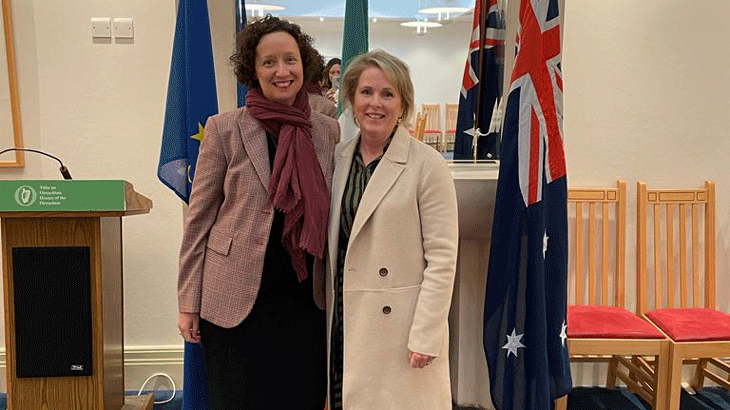Valuable opportunity to see on-farm sustainability work at GASL

Caption: Melinee Leather (pictured with Jo Grainger, Minister Counsellor Agriculture, Australian Mission to the EU) was part of a delegation of Australian representatives to attend the Global Agenda for Sustainable Livestock (GASL) in Dublin last month.
On 7 October the 12th Multi-Stakeholder Partnership Meeting of the Global Agenda for Sustainable Livestock (GASL) wrapped up a week of valuable knowledge exchange and lively discussions about the actions of the livestock sector towards more sustainable food systems.
Almost 150 participants gathered in Dublin, including representatives of the Australian Beef Sustainability Framework’s Sustainability Steering Group (SSG).
We spoke with SSG member, Melinee Leather, on the value of comparing and contrasting the on-farm work of Australian producers in a global setting.
The opportunity to see the sustainability-focused work being undertaken within Irish beef businesses as part of the Global Agenda for Sustainable Livestock (GASL) meeting in Dublin last month was a valuable learning for Australian Beef Sustainability Framework (ABSF) Sustainability Steering Group (SSG) member, Melinee Leather.
“About 84% of agricultural land in Ireland is grassland and grazing systems have traditionally been based on perennial ryegrass pastures, which make up 95% of annual grass seed sales. These pastures are reliant on nitrogen fertilisers which are energy intensive and have negative environmental impacts,” Ms Leather, whose family operation produces beef at Barfield Station near Banana in Central Queensland, said.
“We toured the Devenish Lands farm at Dowth, which is in a UNESCO World Heritage Site, where they’re aiming to produce carbon neutral beef and sheep by 2024. Devenish is a global agri-tech company which employs over 600 people and operates in more than 40 countries, including Australia and New Zealand.
“Their strategy is to optimise nutrient utilisation in soil, plant, animal, environmental and human health, which they tag ‘One Health, from Soil to Society’. The company has found that by increasing species diversity within pastures through the inclusion of grasses, legumes and herbs, dry matter yields improve and nitrogen fertiliser use can be reduced.”
The research also includes projects on biodiversity and heritage. Devenish Lands runs a breeding project for the Grey Partridge, releasing more than 100 birds into the wild each year in addition to working with wild deer that roam freely in the area.
GASL delegates also visited the Grange Animal and Grassland Research and Innovation Centre. The research facility runs similar trials to Australia, Ms Leather said, including measuring enteric methane output, looking at the difference between an animal’s actual and predicted enteric methane. Dietary additives being trialled include halides, seaweed and seaweed extracts, Bovaer(3-NOP) and Yucca/oil extracts, olive feed by-products.
“They’re also running trials on dairy calf-to-beef system evaluation. With 57% of carcases processed in Ireland being of dairy origin, there’s an increasing need and demand for higher quality dairy beef calves. Genetics, age of turn off and feed source are important to the trial and the assessment takes into account physical, financial and environmental performance.”
Ms Leather said she was also interested to see Ireland’s equivalent of Australia’s Producer Demonstration Sites (PDS). Called the Signpost Program, it is led by Ireland’s Agriculture and Food Development Authority (TEAGASC) and is a whole of industry initiative to support farmers to reduce gaseous emissions while improving profitability, water quality and biodiversity, to ensure farm sustainability.
TEAGASC has a Climate Action Roadmap to 2030 to reduce Co2e by 5.75Mt by 2030 and reach climate neutral agriculture by 2050. They have identified mitigation actions and will focus on farmer-to-farmer learning to support idle spread adoption of mitigation technologies.
Back at the conference, delegates were interested to hear what was happening on the ground in Australia from a producer perspective, and Ms Leather shared a snapshot of the projects her family business was involved in.
“I told them about Method to Market (Unlocking ecosystem Services for Livestock producers), Soil Carbon project registered with the ERF, Accounting for Nature Level 3 Soil Method, Australian Biodiversity Remnant Vegetation Pilot and the Steak and Wood project,” she said.
“The Steak and Wood project is looking at Silvopastoral systems and this is gaining a lot of interest in South America and Africa, so we discussed sharing information and maybe attending upcoming conferences in Uruguay.
“I also spoke about the value of collaboration and outlined our work with the State and Federal departments, NRM groups and private sector, as well as the peer-to-peer learning model we use with our Barfield Road Producer Group. It was extremely important for Australia to have a presence at the GASL meeting.”
Ms Leather said there was a consensus that global dialogue, information sharing and building resilience through multi-stakeholder partnerships can enhance the resilience of the sector overall, but that dialogue must be backed up with robust and reliable data verified by science and technology.
“In summary, we need to talk about food nutrition and food security as one. The topic of One Health was raised several times as falling off the radar and needing to be reinvigorated. The importance of good policy, innovation, capacity building, incentives and enabling was universally agreed as being necessary for progress,” she said.
“There are gains to be made with enteric methane reductions and an opportunity to use Silvopastoral practices to balance environment with food security. We need to talk about food nutrition and food security as one.”
More information
Contact:
Resources: